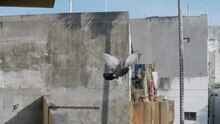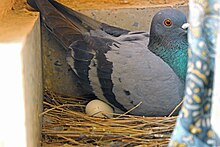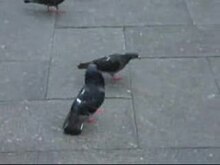The species includes the domestic pigeon, including the fancy pigeon. Escaped domestic pigeons have raised the populations of feral pigeons around the world.[5]
Wild rock doves are pale grey with two black bars on each wing, while domestic and feral pigeons are very variable in colour and pattern. Few differences are seen between males and females.[6] The species is generally monogamous, with two squabs (young) per brood. Both parents care for the young for a time.[7]
Habitats include various open and semiopen environments. Cliffs and rock ledges are used for roosting and breeding in the wild. Originally found wild in Europe, North Africa, and western Asia, pigeons have become established in cities around the world. The species is abundant, with an estimated population of 17 to 28 million feral and wild birds in Europe.[1]
Taxonomy and naming
Columba livia in India
The species is also known as the rock pigeon or blue rock dove, the former being the official name from 2004 to 2011, at which point the IOC changed their official listing to its original British name of rock dove (styled as Rock Dove).[3][12] In common usage, this bird is still often simply referred to as the "pigeon". Pigeon chicks are called squabs.[7]
Subspecies
Twelve subspecies are recognised by Gibbs (2000); some of these may be derived from feral stock.[4]:176–179- C. l. livia, the nominate subspecies, occurs in western and southern Europe, northern Africa, and Asia to western Kazakhstan, the northern Caucasus, Georgia, Cyprus, Turkey, Iran, and Iraq.
- C. l. atlantis (Bannerman, 1931) of Madeira, the Azores and Cape Verde, is a very variable population with chequered upperparts obscuring the black wingbars, and is almost certainly derived from feral pigeons.
- C. l. canariensis (Bannerman, 1914) of the Canary Islands, is smaller and averages darker than the nominate subspecies.
- C. l. gymnocyclus (Gray, 1856) from Senegal and Guinea to Ghana, Benin and Nigeria is smaller and very much darker than nominate C. l. livia. It is almost blackish on the head, rump and underparts with a white back and the iridescence of the nape extending onto the head.
- C. l. targia (Geyr von Schweppenburg, 1916) breeds in the mountains of the Sahara east to Sudan. It is slightly smaller than the nominate form, with similar plumage, but the back is concolorous with the mantle instead of white.
- C. l. dakhlae (Richard Meinertzhagen, 1928) is confined to the two oases in central Egypt. It is smaller and much paler than the nominate subspecies.
- C. l. schimperi (Bonaparte, 1854) is found in the Nile Delta south to northern Sudan. It closely resembles C. l. targia, but has a distinctly paler mantle.
- C. l. palaestinae (Zedlitz, 1912) occurs from Syria to Sinai and Arabia. It is slightly larger than C. l. schimperi and has darker plumage.
- C. l. gaddi (Zarodney & Looudoni, 1906), breeds from Azerbaijan and Iran east to Uzbekistan is larger and paler than C. l. palaestinae with which it intergrades in the west. It also intergrades with the next subspecies to the east.
- C. l. neglecta (Hume, 1873), is found in the mountains of eastern Central Asia. It is similar to the nominate subspecies in size, but is darker with a stronger and more extensive iridescent sheen on the neck. It intergrades with the next race in the south.
- C. l. intermedia (Strickland, 1844) occurs in Sri Lanka and in India south of the Himalayan range of C. l. neglecta. It is similar to that subspecies, but darker with a less contrasting back.
- C. l. nigricans (Buturlin, 1908) in Mongolia and northern China is variable and probably derived from feral pigeons.
Description
Bright orange eye of a pigeon
A distinctive operculum is located on top of the beak
The adult female is almost identical to the male, but the iridescence on the neck is less intense and more restricted to the rear and sides, while that on the breast is often very obscure.[4]
The white lower back of the pure rock dove is its best identification character; the two black bars on its pale grey wings are also distinctive. The tail has a black band on the end and the outer web of the tail feathers are margined with white. It is strong and quick on the wing, dashing out from sea caves, flying low over the water, its lighter grey rump showing well from above.[12]
Young birds show little lustre and are duller. Eye colour of the pigeon is generally orange but a few pigeons may have white-grey eyes. The eyelids are orange in colour and are encapsulated in a grey-white eye ring. The feet are red to pink.[7]
In flight
Group of doves
A pigeon in flight in slow motion, demonstrating the wing movements
Pigeons feed on the ground in flocks or individually. They are scavengers, and frequently feed on human garbage. Pigeon groups typically consist of producers, which locate and obtain food, and scroungers, which feed on food obtained by the producers. Generally, groups of pigeons contain a greater proportion of scroungers than producers.[15] They roost together in buildings or on walls or statues. When drinking, most birds take small sips and tilt their heads backwards to swallow the water. Pigeons are able to dip their bills into the water and drink continuously without having to tilt their heads back. When disturbed, a pigeon in a group will take off with a noisy clapping sound.[16]
Pigeons, especially homing or carrier breeds, are well known for their ability to find their way home from long distances. Despite these demonstrated abilities, wild rock doves are sedentary and rarely leave their local areas.[6]
Distribution and habitat
The rock dove has a restricted natural resident range in western and southern Europe, North Africa, and into South Asia. The rock dove is often found in pairs in the breeding season but is usually gregarious.[4] The species (including ferals) has a large range, with an estimated global extent of occurrence of 10,000,000 km2 (3,900,000 sq mi). It has a large global population, including an estimated 17–28 million individuals in Europe.[1] Fossil evidence suggests the rock dove originated in southern Asia and skeletal remains unearthed in Israel confirm their existence there for at least three hundred thousand years.[5] However, this species has such a long history with humans that it is impossible to tell exactly where the species' original range was.[6] Its habitat is natural cliffs, usually on coasts. Its domesticated form, the feral pigeon, has been widely introduced elsewhere, and is common, especially in cities, over much of the world. A rock pigeon's lifespan is anywhere from 3–5 years in the wild to 15 years in captivity, though longer-lived specimens have been reported.[16] The main causes of mortality in the wild are predators and persecution by humans.[citation needed] The species was first introduced to North America in 1606 at Port Royal, Nova Scotia.[12]Reproduction
Two squabs a few days old
A pigeon incubating its eggs
Courtship display
The nest is a flimsy platform of straw and sticks, laid on a ledge, under cover, often on the window ledges of buildings.[6] Two white eggs are laid; incubation is shared by both parents lasting from 17 to 19 days.[7] The newly hatched squab (nestling) has pale yellow down and a flesh-coloured bill with a dark band. For the first few days, the baby squabs are tended and fed (through regurgitation) exclusively on "crop milk" (also called "pigeon milk" or "pigeon's milk"). The pigeon milk is produced in the crops of both parents in all species of pigeons and doves. The fledging period is about 30 days.[13]
Predators
With only its flying abilities protecting it from predation, rock pigeons are a favourite almost around the world for a wide range of raptorial birds. In fact, with feral pigeons existing in almost every city in the world, they may form the majority of prey for several raptor species that live in urban areas. Peregrine falcons and Eurasian sparrowhawks are natural predators of pigeons that are quite adept at catching and feeding upon this species. Up to 80% of the diet of peregrine falcons in several cities that have breeding falcons is composed of feral pigeons.[18] Some common predators of feral pigeons in North America are opossums, raccoons, red-tailed hawks, great horned owls, eastern screech owls, and accipiters. The birds that prey on pigeons in North America can range in size from American kestrels to golden eagles and can even include gulls, crows, and ravens.[19] On the ground, the adults, their young, and their eggs are at risk from feral and domestic cats.[7] Doves and pigeons are considered to be game birds, as many species have been hunted and used for food in many of the countries in which they are native.[20]The body feathers have dense, fluffy bases and are loosely attached to the skin, and hence they drop out easily. When a predator catches it, large numbers of feathers come out in the attacker's mouth, and the pigeon may use this temporary distraction to make an escape.[21] They also tend to drop the tail feathers when preyed upon or under traumatic conditions, probably as a distraction mechanism.[22]
Preening
Pigeons primarily use powder down feathers for preening, which gives a soft and silky feel to their plumage. Pigeons have no preen gland or at times have very rudimentary preen glands, so that oil is not used for preening. Rather, powder down feathers are spread across the body. These have a tendency to disintegrate, and the powder, akin to talcum powder, helps maintain the plumage.[21] Some varieties of domestic pigeons have modified feathers called "fat quills." These feathers contain yellow oil-like fat that derives from the same cells as powder down. This is used while preening and helps reduce bacterial degradation of feathers by feather bacilli.[23]Parasites
| Tinaminyssus melloi, a nasal mite. | Pigeon louse fly (Pseudolynchia canariensis), a blood-sucking ectoparasite. |
Human health
Contact with pigeon droppings poses a minor risk of contracting histoplasmosis, cryptococcosis, and psittacosis,[25] and exposure to both droppings and feathers can produce bird fancier's lung. Pigeons are not a major concern in the spread of West Nile virus; though they can contract it, they do not appear to be able to transmit it.[26] Pigeons are, however, at potential risk for carrying and spreading avian influenza. One study has shown that adult pigeons are not clinically susceptible to the most dangerous strain of avian influenza, H5N1, and that they did not transmit the virus to chickens.[27] Other studies have presented evidence of clinical signs and neurological lesions resulting from infection, but found that the pigeons did not transmit the disease to chickens reared in direct contact with them.[28][29] Pigeons were found to be "resistant or minimally susceptible" to other strains of avian influenza, such as the H7N7.[30]Domestication
Domestic pigeons
Feral pigeon
Many domestic birds have escaped or been released over the years, and have given rise to the feral pigeon. These show a variety of plumages, although many have the blue barred pattern as does the pure rock dove. Feral pigeons are found in large numbers in cities and towns all over the world.[32] The scarcity of the pure wild species is partly due to interbreeding with feral birds.[14]Stages of life cycle
Osmoregulation
Challenges
C. livia pigeons drink directly by water source or indirectly from the food they ingest. They drink water through a process called double-suction mechanism.[33] The daily diet of the pigeon places many physiological challenges that it must overcome through osmoregulation. Protein intake, for example, causes an excess of toxins of amine groups when it is broken down for energy.[33] To regulate this excess and secrete these unwanted toxins, C. livia must remove the amine groups as uric acid. Nitrogen excretion through uric acid can be considered an advantage because it does not require a lot of water, but producing it takes more energy because of its complex molecular composition.[33]Pigeons adjust their drinking rates and food intake in parallel, and when adequate water is unavailable for excretion, food intake is limited to maintain water balance. As this species inhabits arid environments, research attributes this to their strong flying capabilities to reach the available water sources, not because of exceptional potential for water conservation. C. livia kidneys, like mammalian kidneys, are capable of producing urine hyperosmotic to the plasma using the processes of filtration, reabsorption, and secretion.[34] The medullary cones function as countercurrent units that achieve the production of hyperosmotic urine. Hyperosmotic urine can be understood in light of the law of diffusion and osmolarity.[35]





















No comments:
Post a Comment
Note: Only a member of this blog may post a comment.